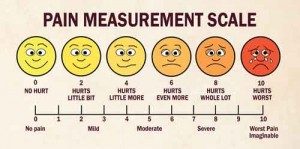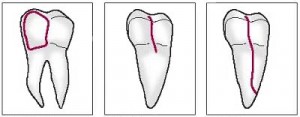What Are the Signs of a Cracked Tooth?
A Crack in a Tooth can be one of the most difficult dental problems to diagnose.
A Cracked Tooth may cause no pain, or it may cause severe pain. You may be able to see a crack in your tooth, or it may be invisible.
Signs that indicate that you may have a Cracked Tooth are:
- pain that comes and goes
- sharp pain when biting down
- pain when releasing after bite
- pain when tooth is exposed to heat or cold
- sensitivity to sweet, sour or sticky food
A crack in a tooth may not be visible with the naked eye, or even in an x-ray. If you suspect that you have a crack in a tooth, try to make a note of where the pain is coming from. You made be avoiding chewing on one side, or one area of your mouth. The more information you have, the easier it will be to find the cracked tooth and repair it.
It’s always a good idea to regular check-ups, to identify potential problems, including a Cracked Tooth.
What Causes a Cracked Tooth?
Even with the best of care, teeth can crack because of:
- structural damage caused by wear
- loss of tooth structure caused by large fillings or other dental restorations
- stress on a tooth
- accidental trauma to the tooth
- grinding or clenching teeth
- uneven pressure while chewing
- chewing on hard objects, like ice, hard candy or nuts
- exposing the tooth to temperature extremes, like hot food followed by an iced drink
How is a Cracked Tooth Repaired?
Repairing a crack in a tooth depends on the type of crack that has occurred. Here’s a look at some types of cracked teeth and how they can be repaired:
- Craze Lines are small cracks in the outer enamel layer of a tooth. They are pretty common in adult teeth and don’t usually need any treatment.
- A Fractured Cusp occurs when a piece of a tooth breaks off the chewing surface of a tooth. This often happens around a filling in the tooth. It can be repaired with a new filling or a dental crown.
- A Cracked Tooth, where the crack extends from the chewing surface toward the root, but not below the gum line, may need to be repaired with a root canal procedure. Early treatment can prevent the crack from spreading and, also, protect the tooth.
- A Split Tooth fracture occurs when the tooth crack has actually separated parts of the tooth, and extends below the the gum. Part of the tooth may be saved, depending on the extent of the damage. It may have to be extracted and replaced with a Dental Implant or other prosthetic.
- A Vertical Root Fracture begins in the root of the tooth. Because it can’t be seen, and might not cause pain, it may go unnoticed for some time.
- Vertical Root Fractures often go undiscovered until the surrounding tissue becomes infected. Treatment depends on the extent of the damage. It may be possible to save part of the tooth or it may have to be extracted.
Unlike a cut in our skin or a chip in a fingernail, a crack in a tooth will not heal. Tooth pain should act as a ‘red flag,” signaling that it’s time to call the dentist.
Please don’t hesitate to call if you’re experiencing any oral discomfort. The pain from a crack in a tooth may come and go, so it’s tempting to ignore it, but early treatment and regular checkups are the best way to maintain or oral and overall health.




